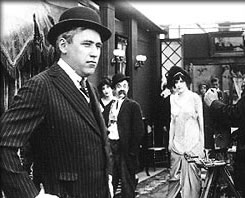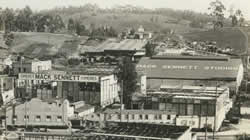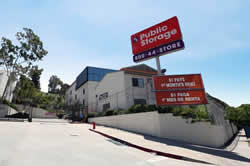Keystone Studios
 Keystone is an example of an early studio.
Keystone is an example of an early studio.
Created in 1912 by Canadian
born Mikall Sinnott (1880-1960), better known as Mack Sennett.
Sennett had been a vaudeville comic and Keystone became famous for slapstick comedies, particularly "Keystone Kops" and the (for the era) provocative "Sennett Bathing Beauties."
Keystone was a pioneer of working class and immigrant humor. The studio cultivated an image of chaos but was also one of the first Fordist studios.
Sennett had a particular gift for finding and mentoring great talent. He "discovered" or mentored Roscoe "Fatty" Arbuckle, Buster Keaton, Harold Lloyd, Charlie Chaplin, Mable Normand, Ford Sterling, Gloria Swanson, Marie Dressler, Bing Crosby, W.C. Fields, and many others.
Keystone existed as an independent studio only until 1915 when it was absorbed by Triangle Films. Sennett left in 1917, but continued to be active in Hollywood until the mid 1930s.
Next: Bitzer, biograph
 Watch Love, Loot, and Crash (a Keystone Kops film from 1915, 11 minutes). Use this link for a version with a musical soundtrack.
Watch Love, Loot, and Crash (a Keystone Kops film from 1915, 11 minutes). Use this link for a version with a musical soundtrack.
You might not be familiar with the term "Fordism" and the related term "Taylorism" but you should know them both. Fordism is the idea that all processes can be broken into a series of timed steps analogous to parts moving down an assembly line. The perfect Fordist model was the Ford River Rouge Complex, at Zug Island, Michigan, just south of Detroit. Completed in 1928, it was then the largest factory in the world. The idea of the Rouge (pronounce roojh) was that raw materials like iron ore, coal, and rubber were unloaded from boats at one end of the factory and finished cars ready to drive away came out of the other. Fordism was the application of this idea to all sorts of other processes. To say that Keystone (and then later all of the Hollywood Majors) was a Fordist studio is to say that it was essentially an assembly line process. There were different divisions such as writing, scenery, art, location, electrical, talent, special effects, stunts, and so on and these operated in a consistent order and consistent manner to produce a consistent product. Using Fordist methods, studios like Keystone could make large numbers of films very rapidly. Of course, that says nothing about the quality of those films. Sennett made over 1,000 films and had as many as 15 movies in production simultaneously. This could only be done with Fordist techniques.
Taylorism is a related concept and refers to "scientific management." The field was founded by Frederick W. Taylor (1856-1915) who was famous for time and motion studies. Taylor used close observation of workers in steel plants and other places to find ways to make plants operate more efficiently. Of course, the problem with both Fordism and Taylorism was that they tended to turn humans into machines. One of the best (and most famous) commentaries on Fordism and Taylorism comes from the Charlie Chaplin movie Modern Times (1936). If you haven't seen it, you owe it to yourself to watch these two scenes: the assembly line and the feeding machine
 If you'd like to see a great short film about silent comedy of this era, check out Buster Keaton - The Art of the Gag a film by Taylor Ramos and Tony Zhou made in 2015. Several Ramos and Zhou films are either optional or required for this class. Ramos and Zhou made almost 30 short films about movies between 2014 and 2016, a series they called Every Frame a Painting. If you're really into movies I suggest watching ALL of them.
If you'd like to see a great short film about silent comedy of this era, check out Buster Keaton - The Art of the Gag a film by Taylor Ramos and Tony Zhou made in 2015. Several Ramos and Zhou films are either optional or required for this class. Ramos and Zhou made almost 30 short films about movies between 2014 and 2016, a series they called Every Frame a Painting. If you're really into movies I suggest watching ALL of them.
You can read a good account of Sennett here.
You're assigned to see Love, Loot, and Crash (link above). I've chosen that film because it's Keystone Kops, and they were cultural icons that you should know about. However, my favorite of the Keystone films is Barney Oldfield's Race for a Life (1913). It's great because it's a spoof on melodramas and it includes several of the key Keystone stars: Ford Sterling, Mabel Normand, and Sennett himself. It also is an early celebrity pic. Barney Oldfield was a celebrity race car driver and plays himself in the film. If you've got a spare 13 minutes or so, click on the link above to see it.
You can click here to find out what the sensational and risqué Sennett Bathing Beauties were all about. It will take you to a 2:35 minute clip from the 1919 short feature Hearts and Flowers. Get an idea of what scandalous was in those days. And some more:

The original Keystone studios was located at 1712 Glendale Blvd. in LA. It was the first fully enclosed sound stage. You can see that Sennett heavily promoted his own name.
 Today, the main building still exists. but it's now a storage facility. It's owner (a national chain of storage facilities) is very aware of the building's history and has provided a blog entry that shows additional photos and provides some historic information. You can read it here.
Today, the main building still exists. but it's now a storage facility. It's owner (a national chain of storage facilities) is very aware of the building's history and has provided a blog entry that shows additional photos and provides some historic information. You can read it here.
 Keystone is an example of an early studio.
Keystone is an example of an early studio.  Watch
Watch  If you'd like to see a great short film about silent comedy of this era, check out
If you'd like to see a great short film about silent comedy of this era, check out  The original Keystone studios was located at 1712 Glendale Blvd. in LA. It was the first fully enclosed sound stage. You can see that Sennett heavily promoted his own name.
The original Keystone studios was located at 1712 Glendale Blvd. in LA. It was the first fully enclosed sound stage. You can see that Sennett heavily promoted his own name.
 Today, the main building still exists. but it's now a storage facility. It's owner (a national chain of storage facilities) is very aware of the building's history and has provided a blog entry that shows additional photos and provides some historic information. You can read it
Today, the main building still exists. but it's now a storage facility. It's owner (a national chain of storage facilities) is very aware of the building's history and has provided a blog entry that shows additional photos and provides some historic information. You can read it